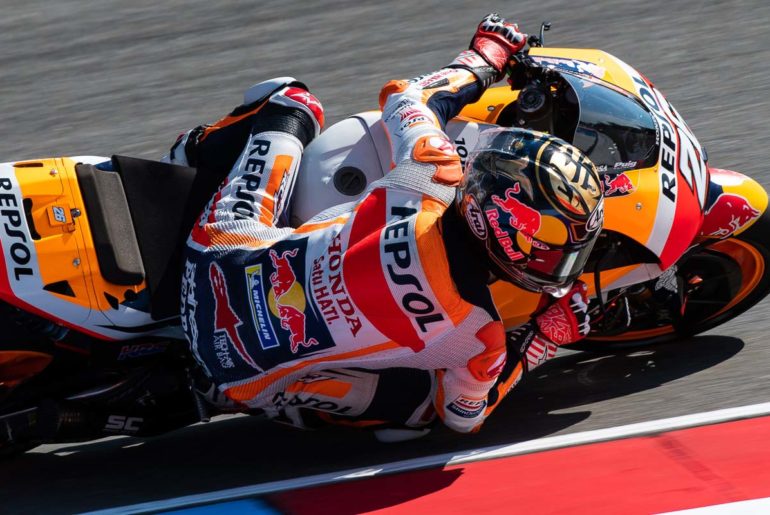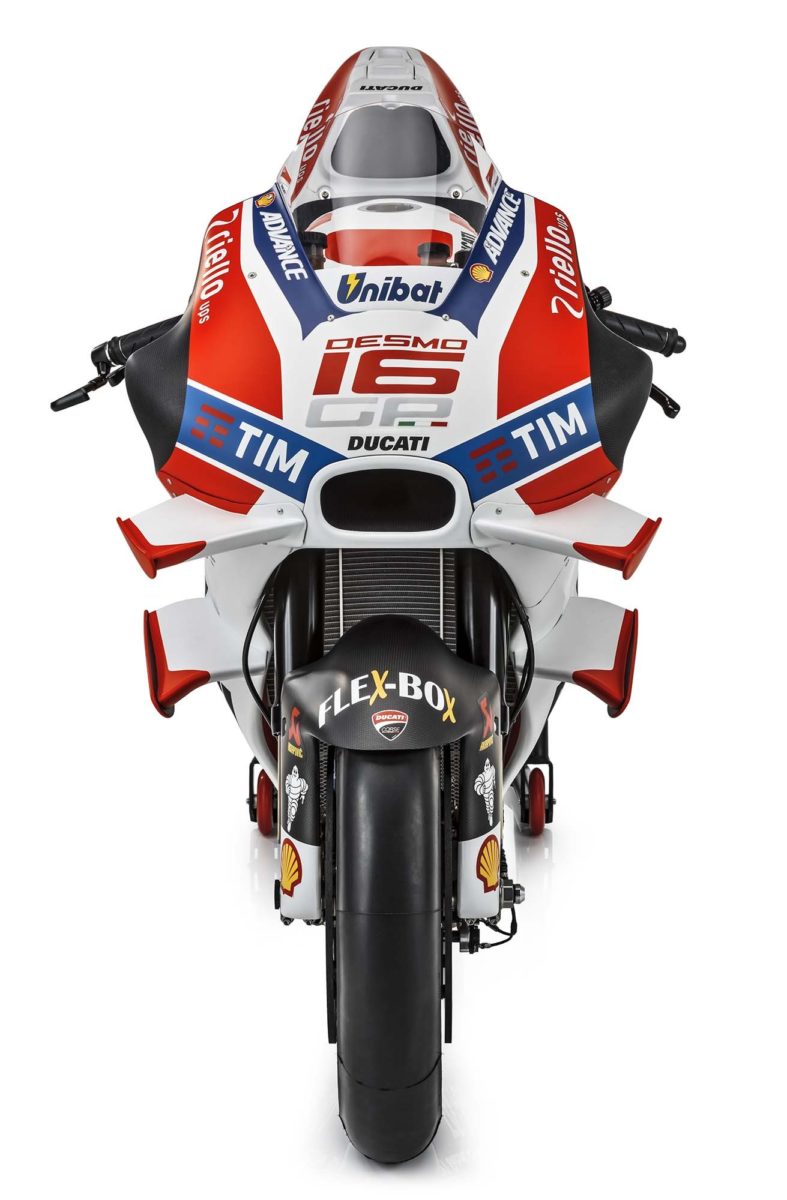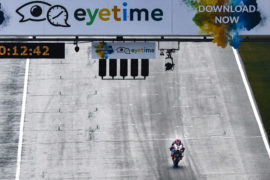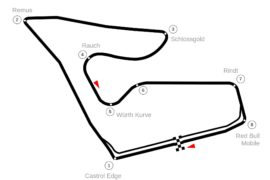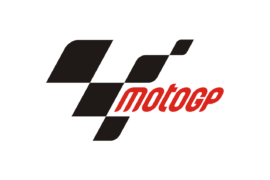It is hot at Brno. It was hot at Assen, it was hot at the Sachsenring, and it is positively scorching at Brno. Air temperatures are at a relatively bearable 34°C, but the asphalt tentatively broke the 50°C during FP2.
That is officially what is known colloquially as a scorcher, testing riders, teams, and above all, tires on the first day of practice at Brno. Where last year, the riders concentrated on the soft and the medium Michelins, on Friday, the MotoGP riders spent their time assessing the medium and the hard.
The downside of forcing Michelin to choose tires for the entire season back in February is that sometimes, their crystal ball fails them, and the weather deviates wildly from what might reasonably be expected. The heatwave which has Europe in a vice-like grip is just such a case.
There are upsides to the heat, though they are perhaps unexpected. There were just four fallers at Brno on Friday across all three classes, less than half the number from last year, a third of the number in 2016, and a massive five and a half times fewer than the 22 crashers in 2015. It’s hot and dry, so the tires will definitely grip.
Sometimes a little too much, as Jorge Martin found to his dismay in Moto3 FP1.
The Spaniard managed to highside his Del Conca Gresini Honda Moto3 bike and break the radius bone in his left wrist, ruling him out of action for Sunday’s race, and making him doubtful for next week’s Austrian round at the Red Bull Ring.
Martin had steadily built up a lead over Marco Bezzecchi in the Moto3 championship in the last two races, only to throw it away with a huge mistake at Brno. There may only have been four crashes on Friday, but one of them was very costly indeed.
In the MotoGP class, the timesheets tell a rather deceptive tale. Dani Pedrosa finished the day faster, and digging into the timesheets, he looks quick on old tires and in race trim. Danilo Petrucci was second quickest overall, and also showed solid pace.
But the Pramac Ducati rider was convinced that the riders with real race pace were behind him, Andrea Dovizioso in fifth, and Marc Márquez in tenth. Not where you might necessarily expect to find the fastest riders on the day.
The Luxury of Strategy
“For sure they are hidden, but I think that’s a working method, a little bit different,” Petrucci explained. “Because I think they are a little bit faster than everyone, and they can take this risk to work more on the bike when the tire is used, because tomorrow morning, they know that with one lap they are in front.”
“So fortunately for them, they can work on the bike for one or two runs more than our situation. Because tomorrow is a qualifying, more or less. Today you spend the last run on the new tire, so they can see, they can collect data, they can ride the bike with used tires, so they will have more experience.”
Marc Márquez acknowledged that this was exactly what he was doing, though it went against his natural instinct. “Of course I’d like to go to sleep tonight with the fastest lap time or try to be on the top, but I have understood this,” the Repsol Honda rider told us.
“Especially last year, as it was the strategy for Dovizioso last year. Prepare for the race, and tomorrow we will try to be in the top 10.”
That strategy does not come without risk. “You have one chance,” Márquez said. “For this reason sometimes it is more risky like it happened to me in Mugello that I went into Q1, or Montmelo. But it is the way to understand how to work otherwise it is impossible to understand what you need.”
Chicken and Egg
Andrea Dovizioso agreed with Márquez, as you might expect given that Márquez had taken the strategy from Dovizioso. “The problem is that you are only able to do that when you are fast,” the factory Ducati rider explained.
“Because if you are not fast enough and you are out of the top ten, you never know if you are ready for the next practice. So everybody puts the soft tire at the end of practice, because everybody wants to be in the top ten.”
“If you are able to be fast when you try the pace, you can do that. That’s the reason why most of the riders don’t do that.”
Dovizioso was confident he had the speed, however. “It was really good, even better than what we expected,” he said. “Our speed is really good, and that is the best you can have on the first day, because it gives you the chance to make more laps on the tires, and you are able to work a lot for the race.”
“We didn’t put the soft tire at the end, like Marc, and we are in the top ten, which is very important and positive. We showed really good speed, with used tires, with a new tire, so really happy.”
“That doesn’t mean this will be enough, because the consumption of the tire is the biggest point, so we are working a lot on that. It’s not easy, but I’m really happy about the first day.”
Where’s the Beef?
Why risk dropping out of the top ten on Friday, and gamble on the weather being good enough on Saturday morning to take a shot at trying to get straight through to Q2 in FP3? Because by not worrying about qualifying on Friday, you effectively buy yourself another 30 minutes of practice to work on race setup.
Most riders spend the first half an hour of FP1 and FP2 working on the race, before switching to new tires and a more powerful engine setting to try to secure passage to Q2.
That means you have to focus on one bike for your race setup, while the mechanics get the second bike ready for a pre-qualifying dash in the final fifteen minutes. Time spent on qualifying is time lost to race setup, a lack which only becomes apparent on Sunday afternoon.
Danilo Petrucci explains: “Here, we have to prepare one bike for the fast lap, for the qualifying, and one bike to make all of the race.”
“The bikes are very different comparing between the race pace tire and the qualifying tire, so you have to deal with the electronics, with the setup, you have to understand a lot of things. For sure the bike changes a lot during lap by lap. And you have to care very, very much about the pace of the race with a used tire.”
A quick look at race pace shows that Márquez is indeed quick, with Dovizioso not a million miles behind. Dani Pedrosa is running low 1’57s consistently, and Andrea Iannone is pretty consistent as well, despite having missed out on Q2 by ending the day in eleventh.
Marc Márquez’ assessment was broadly similar, though he played down his own strength. “At the moment I think the fastest guy on the track is Dovizioso,” he said, “but then it is Dani, me and two or three more riders with a very similar pace.”
Tire Wear
The big issue for everyone is the consumption of the rear tire, especially in the heat at Brno. Tires coming back into the pits looked very well used, beyond what you might expect in cooler temperatures.
That made it imperative to focus on race pace, and not worry too much about qualifying. But that was a luxury only Andrea Dovizioso and Marc Márquez could afford, while others struggled to keep pace.
“For sure it was a difficult day,” Valentino Rossi said on Friday afternoon. “The conditions are at the limit with more than 50 degrees on the asphalt. It’s difficult to manage.”
“It’s also difficult to ride the bike at the maximum because it looks like the track have quite a lot of bumps, like a little worse compared to last year. So it’s not easy. I don’t have a fantastic feeling, especially in the front. We still have to work.”
That wasn’t his main concern, however. “For me the main issue, the biggest problem will be the rear tire degradation. Here the rear tire drop a lot. After three or four laps you lose a lot of grip and you have a lot of spin so it’s difficult to keep the right pace.
So we have to work a lot on this point, in this area. It looks like the situation is not very clear still because a lot of top riders try different tire options front and rear. I don’t try the harder option but a lot of riders like it. Tomorrow I will try. Maybe tomorrow we can understand in a better way our level.”
Tire degradation was not peculiar to Yamaha, however. “I think everybody suffers,” Rossi said. “It depends who suffers less. When you put the new tire you have two laps where you are fast and it’s very easy to improve the lap time.”
“But for 21 laps I think the key for arrive on the podium is to try and suffer as less as possible. The rear degradation is a lot, so you lose a lot of performance, you lose a lot of time. The track is also long so the gap become bigger.”
A Hardware Problem, Not a Software Problem
Yamaha still haven’t brought a solution to their tire wear problem, something both Rossi and Viñales have been pushing very hard for throughout the season.
The issue, Yamaha’s MotoGP project leader Kouji Tsuya told a press conference of the technical leaders of the MotoGP manufacturers, was down to a fundamental design issue of the engine.
“We have to concentrate to improve the acceleration,” Tsuya-san said. “Also by electronics, and also by chassis, but unfortunately we cannot change the engine configuration.”
Tsuya-san did not elaborate further, but a conversation with MotoGP technical guru Neil Spaldingproved enlightening. Spalding believes that the issue is down to the crankshaft, which he labeled “probably the most important component after the tires.”
Like Suzuki last year, Yamaha got the mass of the crankshaft wrong, though they erred in making it too light, rather than too heavy. That is making it more difficult to control acceleration (and deceleration), which is making the rear tire spin, and causing it to degrade.
Yamaha will have to wait for 2019 to be able to fix that, however, as the technical regulations mean that engine design is frozen for the season at Qatar.
The way to fix this, of course, is to get the engine right in testing, something which both Suzuki and Honda have done this year.
Testing is the next big focus for Yamaha, the Japanese factory finally buckling and deciding to set up a European-based test team, much to the delight of Valentino Rossi and Maverick Viñales.
“I push a lot for the [European test] team,” Valentino Rossi said. “I think it’s a great idea, because to work with the test team in Japan is a bit difficult because, first of all, the tracks in Japan are very different compared to Europe.”
“So I think it will be very important for Yamaha. And also the rider is very important, because to understand something you need a rider that is fast like me and Maverick or maybe just a little bit less.”
“I think we have some different names on the list. [Bradley] Smith is one, [Jonas] Folger is another, that already knows the bike. It’s important to a have a rider that is not too old and can go quite fast.”
Loopholes Exploited
At Ducati, Danilo Petrucci was playing the role of test mule, debuting the latest update of their aerodynamic fairing.
The fairing (shown in a tweet from the Alma Pramac Racing Team below) has two components, an upper mini-moustache-like loop similar to the parts used by Yamaha and Honda on the upper part of the fairing, and a reduced box duct on the lower side of the fairing, similar to the current fairing:
New fairings for @Petrux9#forzaDucati #CzechGP #DP9 #pramacracing #MotoGP pic.twitter.com/QcMbYt4tT0
— Alma Pramac Racing MotoGP (@pramacracing) August 3, 2018
What Ducati appear to have attempted is to recreate the most successful iteration of their winged fairing, before the ban on unprotected winglets came into force. There is an upper winglet to provide anti-wheelie, and a side wing to add some stability, as pictured below.
Whatever they have done, it appears to have worked. Petrucci was certainly delighted with the new fairing, setting his fastest time with the new fairing and not finding any negatives with it.
“The biggest point is that the new fairing has no negative points,” Petrucci said. “So I mean there is not the difference between day and night. We don’t gain 10 km/h in the straight, I don’t know if we gain anything, because it’s like 1, 2, 3 km/h, but I’m not sure.”
“The positive point is that the handling is better, it’s not so heavy to change direction. And when you try something new and it has no negative points, it’s OK, because you can compare.”
“And especially we did a comparison, one bike with the old fairing, one bike with the new fairing, with identical bikes. And this is good, because it means the work done is better.”
Petrucci’s test work was welcomed in the factory Ducati team, where both Andrea Dovizioso and Jorge Lorenzo were encouraged by the results. They will likely use the fairing on Saturday, with an eye to using it in the race.
If the fairing is as good as Petrucci suggests, and improves the anti-wheelie function without making the bike more difficult to turn through the corners, they will have made a major step forward. Saturday will be the proof of the pudding.
Photo: © 2018 Tony Goldsmith / www.tonygoldsmith.net – All Rights Reserved
This article was originally published on MotoMatters, and is republished here on Asphalt & Rubber with permission by the author.

